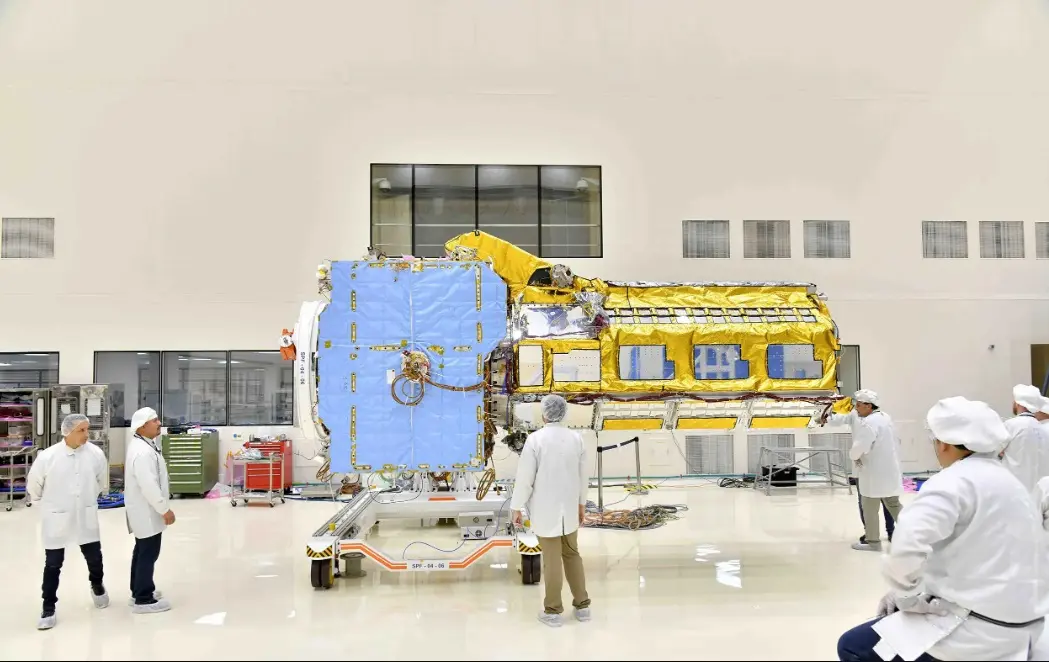In a Remarkable Milestone, Bengaluru, India Witnesses the Fusion of Two Key Components, Forging NISAR Satellite into a Singular Spacecraft!
Bengaluru, NFAPost: In a historic joint effort, NASA (National Aeronautics and Space Administration) and ISRO (Indian Space Research Organisation) have reached a significant milestone in their collaboration with the successful combination of two major components of the NISAR satellite. NISAR, short for NASA-ISRO Synthetic Aperture Radar, is an ambitious project aimed at closely tracking movements on Earth’s land and ice surfaces with unprecedented precision. This cutting-edge satellite is poised to be launched in early 2024, promising to revolutionize our understanding of the planet.
At the core of the NISAR mission lies its synthetic aperture radar (SAR) technology, which enables it to capture highly detailed images of various Earth features. Unlike previous Earth-observing missions, NISAR will cover almost every part of the planet at least once every 12 days, allowing for comprehensive monitoring of dynamic environments like forests, wetlands, and agricultural lands.
One of the most remarkable aspects of the NISAR mission is its collaborative nature. For the first time in history, NASA and ISRO are pooling their expertise and resources to jointly develop the satellite’s hardware. The Jet Propulsion Laboratory (JPL), managed by Caltech in Pasadena, leads the U.S. component of the project, contributing to the L-band SAR payload and other critical elements. Meanwhile, the URSC (U R Rao Satellite Centre), spearheading the ISRO component, is responsible for the spacecraft bus, S-band SAR electronics, and the launch vehicle, among other vital components.
The heart of the satellite consists of two SAR systems: NASA’s L-Band SAR payload and ISRO’s S-Band SAR payload. These systems work in tandem and rely on a large unfillable reflector antenna, approximately 12 meters in diameter, provided by both agencies.
In addition to the SAR systems, NASA brings in a range of engineering payloads for the mission. These include a Payload Data Subsystem, a High-rate Science Downlink System, GPS receivers, and a Solid State Recorder, all of which further enhance NISAR’s capabilities.
The NISAR mission promises numerous benefits across various scientific and practical domains:
1. Advancing Earth Science: NISAR’s comprehensive data and insights into Earth’s surface changes and natural hazards will significantly contribute to our understanding of Earth system processes and the complex dynamics of climate change.
2. Empowering Disaster Management: The satellite’s real-time information will prove invaluable for managing natural disasters like earthquakes, tsunamis, and volcanic eruptions. Faster response times and more accurate risk assessments are expected as a result.
3. Improving Agriculture and Food Security: NISAR data will be leveraged to enhance agriculture management by providing crucial information about crop growth, soil moisture levels, and land-use changes, ultimately contributing to global food security.
4. Strengthening Infrastructure Monitoring: The mission’s data will play a pivotal role in monitoring and managing critical infrastructures, such as detecting oil spills, urbanization patterns, and deforestation activities.
5. Monitoring Climate Change Impacts: NISAR’s observations will aid in monitoring and understanding the effects of climate change on Earth’s land surface, including the melting of glaciers, rising sea levels, and shifts in carbon storage.
As the launch date approaches, excitement is building within the scientific community for the groundbreaking opportunities that NISAR will bring. This landmark collaboration between NASA and ISRO represents a giant leap forward in Earth observation, and the mission’s success could herald a new era of international cooperation in space exploration and research. With NISAR’s keen eye on our planet, humanity will gain an unprecedented vantage point to study and safeguard the delicate processes that shape our home.





